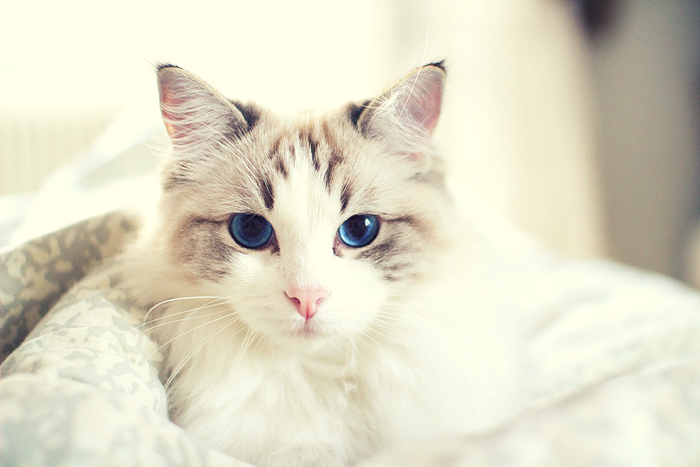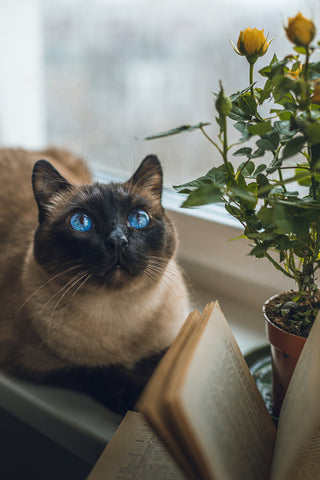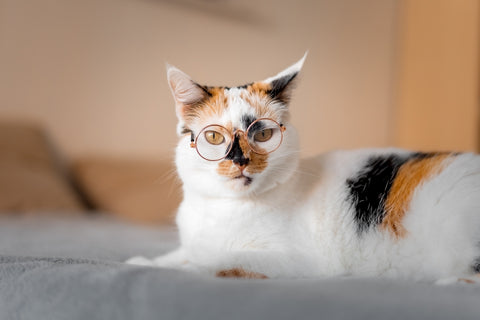
Cat coat genetics: Summary of main genes
1. Brown, chocolate, cinnamon and similar coat colors are products of the feline primary gene for coat color (B/b/b1). This gene codes for the eumelanin pigment. Dominant allele B codes for black color, recessive allele b for chocolate and recessive allele b1 for cinnamon. The intensity and pattern of these colors depends on the other genes involved in formulating the final feline phenotype.
2. The co-dominant red gene (O/o), found on the X chromosome, determines whether there will be any red variations to fur color or not. This gene encodes phaeomelanin. The dominant allele O codes for orange tones, and the recessive allele o for the non-orange pigmentation (black or brown). Because males have just one copy of the X chromosome, they can carry only one of the alleles of this gene – either O or o. If they carry the allele O, they will be red, orange or creamy (depending on the variation), otherwise they won’t have any orange tones to their fur.
Females have two X chromosomes which means they will carry two alleles of the gene. If they are dominant homozygotes (OO), they will be red toned, recessive homozygotes (oo) won’t have any orange tones and heterozygotes (Oo) will be tortoiseshell. This is the reason why male tortoiseshell cats are so rare.

3. Dense/dilute pigment gene (D/d) codes for melanophilin. This gene alters the original coat pigmentation by affecting the deposition of the pigment in the hair. If a cat is a recessive homozygote dd, then the black cats will appear gray, the brown will be lilac, the cinnamon will become fawn, and the orange cats will turn cream. Dominant homozygotes DD and heterozygotes Dd are not affected and express the original coat color.
4. The tyrosinase gene (C/c/c1) codes for the tyrosinase enzyme. The dominant allele C codes for a fully functioning protein and all the carriers will show full coat pigmentation. The recessive alleles (c and c1) code for a mutated tyrosinase and result in one of the two forms of albinism: complete and temperature sensitive (more about this in the "White cats" section).
5. The KIT gene determines whether or not there will be any white in the coat. The wild-type allele of this gene is recessive (w) and homozygotes for it won't have any white in their coat. Other KIT alleles are dominant white (WD), white spotting (WS) and recessive Birman white gloving allele (wg).
The dominant white gene (WD) encodes complete white coloration by disrupting replication and migration of melanocytes into the skin. It is also associated with blue eyes and deafness. Because it's inherited in a dominant manner, one variant is enough for the trait to be expressed. The carriers of this allele are white regardless of any other color-associated gene.
The white spotting gene (WS) is also dominant, but it only disrupts migration of melanocytes to certain patches in the skin, thus leading for formation of white spots/areas.
And finally, the Birman gloving allele (wg) is recessive (two alleles are required for expression), and it causes the white gloves specific for the Birman breed (but it can be found in other breeds too).
Cat coat genetics: Pattern types
Bicolor, Tuxedo or Van
This is a coat variation in which the cat has one primary (non-white) color with white parts. The pattern varies from Tuxedo – when the cat is mostly black with a little bit of white on its chest, to Van – mostly white with colored tail and top of the head. The base color can be black, red or tortoiseshell. It is the white spotting gene (WS) that causes the white spots or patches in the fur. Dominant homozygote (WSWS) expresses more extensive white patching compared to the heterozygotes for this allele.
Tabby
Tabby divas have marbled pattern consisting of butterflies, bullseyes, stripes, spots or swirling patterns. Their forehead is also often marked with an "M" shape. Taking a closer look at a single hair of a tabby can reveal that it’s banded with different colors. This pattern is the result of the dominant allele of the agouti gene (A). The agouti gene allows full pigmentation when the hair first starts to grow, then it slows down the synthesis of the pigment, and then speeds it up again. This creates the pigmented bands along the hair. The agouti banding can be observed in both eumelanistic (black-based) and phaeomelanistic (red-based) coats.

The recessive allele of this gene is called non-agouti. Only recessive homozygotes for this gene (a/a) will result in solid coloration. The tabby pattern of the coat, however, is determined by the tabby gene. This gene is what will cause these banded hairs to alternate with stripes, spots or solid patches. There are four tabby patterns recognized: mackerel, classic, spotted and ticked. Tabbies can also be a part of another basic coat pattern such as calico or tortoiseshell.
The four tabby patterns:
1. Mackerel tabbies, or popularly known as "fishbone tabbies", are characterized with vertical stripes on the sides. The narrow lines can be continuous or broken into bars and spots on the flanks and stomach. This is the most common tabby pattern.
2. Classic tabbies, often nicknamed as "blotched" or "marbled", sport swirled patterns on their sides. On the shoulders there is a light "butterfly" pattern, and three thin stripes down the spine.
3. Ticked tabbies are stripe-less. They have bands of colors and sand-like appearance.
4. Spotted tabbies have stripes broken down into smaller or larger spots. This pattern is often observed among Bengal, Serengeti, Egyptian Mau, Arabian Mau, Maine Coon and other breeds.
Tortoiseshell and calico (or tricolor)
Tortoiseshell is a pattern characterized with mottled patches of orange and non-orange, most commonly black (or their diluted forms: cream, ginger, red and blue, tabby, gray). These beauties can also have white spots in their fur. Calico versions, aka tricolor cats, have a significant amount of white in their coat, and the red and black patches are not mottled but form patchwork. Thus, all calico cats are tortoiseshell, but not all tortoiseshell cats are calico.

Tortoiseshell and calico cats are almost exclusively female. The reason for this is because the pattern is a result of a differential X chromosome inactivation, and males carry only one copy of the X chromosome.
Female cats carry two copies of the X chromosomes in their cells. One of these chromosomes will be silenced in all of the cells by a random chance. This means that in some cells one X chromosome will be silenced and in the other cells the other one. It is completely random. As already mentioned, the gene for the orange color (O/o) lies on the X chromosomes and comes in two variants (alleles) – the orange (O) and the non-orange (o). The orange allele O codes for the orange pigment "phaeomelanin", and the non-orange o for the black/brown pigment "eumelanin".
If a female cat is a heterozygote for this gene (Oo), it will carry the orange allele (O) on one X chromosome and the non-orange allele (o) on the other X chromosome. The cells in which the first X chromosome is silenced will express only the non-orange gene, and therefore produce the black (or brown) pigment, and the other cells will produce the orange pigment. This is why some patches on the coat will be orange and some will be black.
Additionally, a recessive dense pigmentation gene (D/d) can modify the O/o gene. It can modify orange to cream, black to gray or blue etc. This is why some tortoiseshell cats are chocolate or blue.

The third color of a tortoiseshell is a product of a completely separate gene. If they have the white patches, then these are a result of the white spotting gene, as explained above.
Since the male cats carry only one copy of the X chromosome (and a Y chromosome), there is no X inactivation in their cells. This means that they will possess only one allele of the O/o gene present on their X chromosomes and it will be expressed in all the cells the same. Thus, male cats will either be all orange or completely non-orange. The rare male tortoiseshell accidents are usually a result of either an extra X chromosome (XXY), or they are chimeras.
Colorpoint
Colorpointed beauties have darker pigmentation on their faces, ears, feet and tails, and a lighter coloration on the rest of their body. The pointed pattern is a form of partial albinism, due to a mutation in tyrosinase (enzyme involved in the production of melanin). The mutated version of this enzyme is heat-sensitive, and it fails to work at normal body temperatures. It activates only in cooler areas of the skin (lower than 33 °C). Therefore, coolest parts of the body will be pigmented darker than the rest, such as extremities and face.These pigmented points can be very dark in color, almost black, or cool grey, light brown or lilac.
Siamese cats are most commonly associated with this coat pattern, but many other domestic cats can also be colorpointed.

Silver pattern
The silver coat pattern is the pattern in which only the tips of the hair are actually colored (the color starts in the middle of the hair, or only the very tips are colored). This is the result of the melanin inhibitor gene (I/i) which alters the expression of the primary gene for colors (encoding eumelanin) and the red gene (encoding phaeomelanin). The dominant allele of this gene (I) suppresses the eumelanin or phaeomelanin production, which fades the base of hair in solid cats (making them silver smoke), and turning tabbies into a sparkling silver color (while leaving the stripes intact).
Silver tabbies can be silver striped (with half of the hair pigmented), silver shaded (less than half of the hair is pigmented) or silver tipped, aka chinchilla (only the very tips of the hairs are colored). These effects are impacted by other genes as well as the width of the bands in tabbies (which are also genetically determined), and its formation depends on the expression of the number of genes and their interaction. There are also golden patterns formed by a similar interaction of various genes.
White cats
There are two ways in which a cat may turn out to be completely white in appearance. In the first scenario, there is a mutation in the tyrosinase gene, and in the second case there is a lack of melanocytes in the skin.
1. The gene coding for the tyrosinase enzyme is the C gene. The dominant allele codes for a fully functional protein, and all the carriers will show full coat pigmentation. There are two recessive alleles of this gene that cause two forms of albinism: complete and temperature sensitive. The temperature sensitive albinism (explained above) is expressed in e.g. Burmese, Siamese and Tonkinese breeds. The allele causing the complete albinism results in the appearance of the fully white cat. True albinism is a very rare case though.
2. The disrupted replication and migration of melanocytes into the skin is caused by the dominant allele of the KIT gene. All the cats carrying this allele (WD/WD and WD/w) will appear white, even if they carry other color genes. Only recessive homozygotes (w/w) will express the normal pigmentation. These cats are at a higher risk from congenital deafness and skin cancer.

Smoke cats
This is a pattern in which the cat has a solid base color, but the bottom eighth of each hair is white or creamy.
Cat coat genetics: Length and texture
Cat coat length is controlled by the gene named the fibroblast growth factor 5 (FGF5). The dominant allele codes for short coat. Four mutations have been identified in this gene that code for long coat – all of which are recessive. According to the study by Kehler J.S. et al (2007), mutations 1 and 2 were unique to the Ragdoll and Norwegian Forest cat breeds, respectively, while mutation 3 was found only in Maine Coon and Ragdoll cats. Mutation 4 was the most prevalent mutant in the study and it was detected in all long-haired breeds sampled (Kehler et al, 2007).

Curly coat is produced by various genes. In fact, new types of curly cats sometimes spontaneously occur in freely bred domestics. Some of the identified genes to produce “rex” cats are r (Cornish Rex), gr (German Rex), re (Devon Rex), ro (Oregon Rex) and Lp (provisional). Of all the named genes, only Lp is the dominant allele and it was identified in LaPerm breed. There are many other genes that produce curly divas. More on curly coat here.
Genes associated with hairlessness have also been identified. In Peterbald and Russian Donskoy, dominant allele Hp was identified to cause this trait. In British hairless cats and French hairless cats, recessive alleles hd and h, respectively, have been noted to be linked to the character. And, in Canadian Sphynx cats, hairlessness is controlled by the recessive hr allele.

Cat coat genetics is an extremely complex, but peculiar issue. So many identified genes are involved in making every feline just as special and unique as they are. Are you curious about your cat’s genetic background and health? Get a Basepaws Cat DNA test!
Learn More
Citations:
- James S. Kehler, Victor A. David, Alejandro A. Schäffer, Kristina Bajema, Eduardo Eizirik, David K. Ryugo, Steven S. Hannah, Stephen J. O’Brien, and Marilyn Menotti-Raymond. (2007). Four Independent Mutations in the Feline Fibroblast Growth Factor 5 Gene Determine the Long-Haired Phenotype in Domestic Cats. J hered. 8(6): 555–566. doi:10.1093/jhered/esm072



